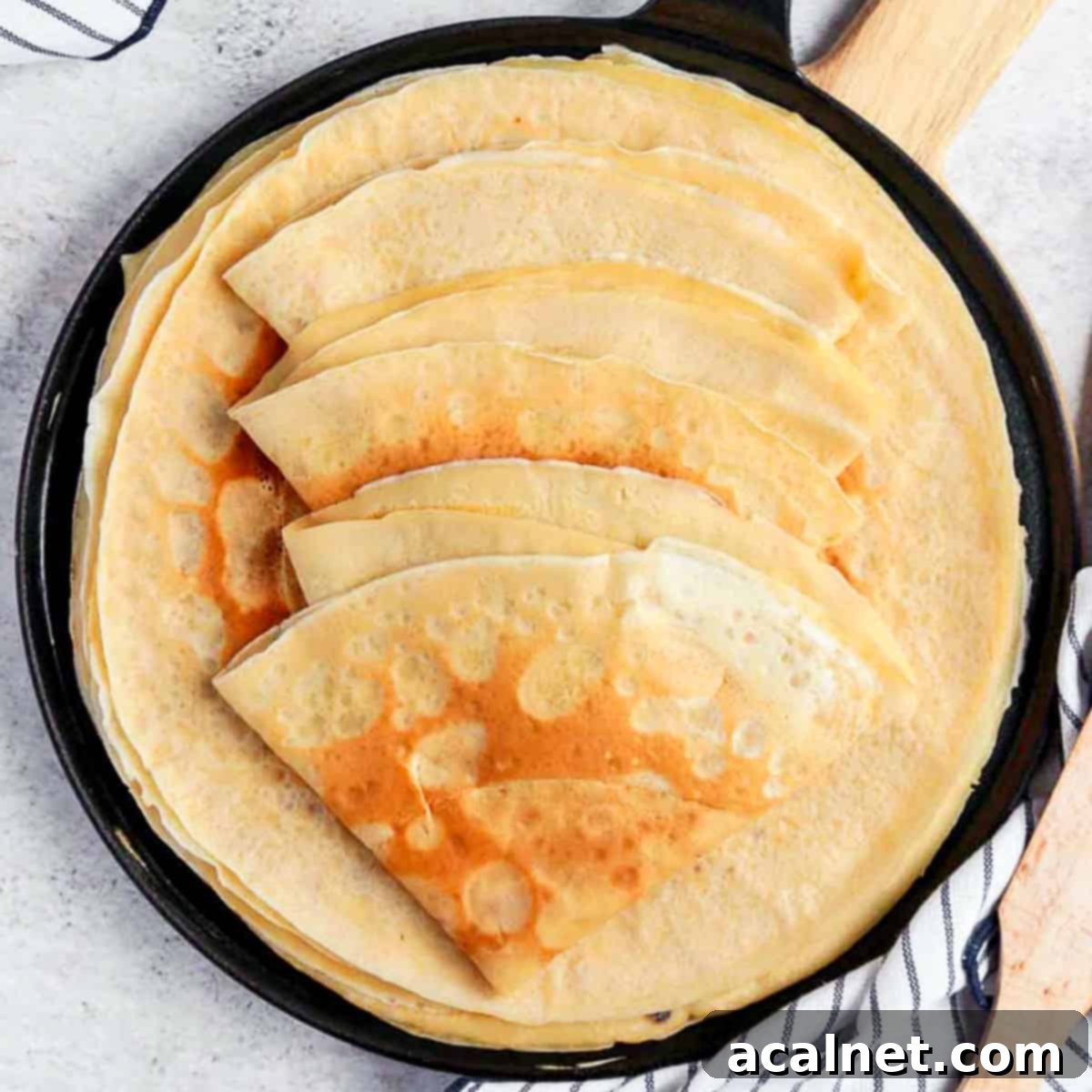Authentic French Crêpes Recipe: Your Guide to Perfectly Light Homemade Pancakes
Embark on a delightful culinary journey to the heart of France with this authentic French Crêpes recipe. This cherished method, passed down through generations, guarantees the lightest, thinnest, and most wonderfully soft crêpes you’ll ever taste. Forget complicated techniques; these elegant French pancakes are surprisingly easy and incredibly fun to prepare, making them an ideal treat for any occasion. Whether you’re planning a special breakfast, an afternoon tea gathering, or a show-stopping dessert, these versatile crêpes serve as the perfect canvas for your favorite sweet or savory fillings, promising a truly memorable experience with every bite.

[feast_advanced_jump_to]
Why You’ll Adore This French Crêpes Recipe
This particular French crêpes recipe holds a special place in my heart, and for good reason: it’s my Mum’s time-honored recipe. For over four decades, this traditional method has brought joy to our family, delivering consistently delicious results every single time. It’s more than just a recipe; it’s a taste of home and tradition.
Beyond sentimental value, I truly adore these authentic French Crêpes because they are incredibly light and airy, with a melt-in-your-mouth texture that sets them apart. They are remarkably easy to make, requiring only a few basic ingredients typically found in any pantry. Yet, their simplicity belies their versatility; you can effortlessly customize them with various flavorings to create endless delicious variations. Imagine transforming them into elegant sweet desserts or hearty savory meals!
While the process of cooking each crêpe individually might seem a little time-consuming, I promise you, the reward is absolutely worth the effort. The delightful treat you get at the end makes it a perfect activity for a relaxed Sunday afternoon, or any time you crave a touch of French culinary magic.
What Exactly is a French Crêpe?
A crêpe is a quintessential traditional French pancake, fundamentally distinct from its American counterpart. At its core, a classic crêpe is crafted from three basic ingredients: flour, eggs, and a liquid, most commonly milk. In France, these versatile delights are served in two primary ways: as a sweet dessert, where a touch of sugar is added to the batter, or as a savory dish, omitting the sugar and often incorporating more salt into the mixture.
What truly differentiates French crêpes is their remarkably thin texture. Unlike American pancakes, crêpes contain no baking powder or any other leavening agent, which means they don’t rise. This absence of leavening results in their signature paper-thin, delicate, and soft consistency. It’s also worth noting the regional variation: Buckwheat Crêpes, known as Galettes de Sarrasin, originate from the French region of Brittany. These savory galettes are made with buckwheat flour, giving them a distinctive nutty flavor and slightly chewier texture, often filled with ham, cheese, and an egg.
To enrich the flavor and texture of the batter, melted butter (or even nutty brown butter for an extra depth of taste) is a common addition. Beyond this, countless ingredients can be used to infuse the crêpes with unique flavors, such as fragrant vanilla extract, bright lemon or orange zest, aromatic orange blossom water, or even a splash of alcohol like Grand Marnier or Rhum for a sophisticated touch.
Essential Ingredients for Perfect Crêpes

For precise quantities, please refer to the comprehensive recipe card below.
To create these delightful French crêpes, you’ll need just a few fundamental items:
- Flour: Standard plain or all-purpose flour is ideal for these delicate pancakes. If you’re exploring gluten-free alternatives, I highly recommend checking out my French Buckwheat Crêpes recipe, which uses buckwheat flour for a unique taste and texture. Remember to also include a small pinch of Fine Table Salt; it’s crucial for balancing and enhancing all the flavors in the batter.
- Caster Sugar: Also known as fine white sugar. The amount of sugar can be easily adjusted to match your preference, allowing you to create sweeter crêpes for dessert or reduce it significantly for savory applications.
- Milk: Full cream or whole milk is highly recommended for the richest flavor and most tender crêpes. However, if you need a dairy-free option, plant-based milks like almond or oat milk can be successfully substituted.
- Butter: Unsalted butter, melted, adds a wonderful richness and depth. For an elevated flavor profile, consider making brown butter. Simply melt the butter in a small saucepan and continue cooking it gently until the milk solids separate, turn golden brown, and release a delightful nutty aroma. This simple step adds an incredible dimension to your crêpes.
- Eggs: Large eggs, ideally at room temperature, help create a smoother batter and integrate more easily with the other ingredients.
Optional Additions & Flavor Variations
The beauty of crêpes lies in their adaptability. You can easily infuse the batter with various flavorings to suit your taste:
- Vanilla Extract: A classic choice that adds a warm, sweet aroma.
- Lemon Zest or Orange Zest: For a bright, citrusy lift that pairs wonderfully with sweet fillings.
- Orange Blossom Water: A traditional French addition that imparts a delicate, floral fragrance.
- Alcohols: A splash of Grand Marnier (orange liqueur) or Rhum (rum) can add sophisticated depth, especially for dessert crêpes.
- Cocoa Powder: Incorporate unsweetened cocoa powder to transform your plain crêpes into delicious chocolate crêpes, perfect for a rich dessert.
For the batch featured in this recipe, I included about 1/2 teaspoon of pure Vanilla Extract and the finely grated zest of 1/2 a Lemon for a subtle, aromatic hint.
Smart Ingredient Substitutions
- Milk: While milk provides the best flavor and richness, you could technically substitute it with water. However, expect a noticeable difference in taste and texture, as the crêpes will be less rich. A brilliant tip I learned from my mother is to substitute half of the milk with Mineral Water. This clever trick helps create exceptionally light and airy crêpes, a delightful secret for a truly delicate finish!
- Butter: Unsalted butter is preferred for its flavor, but it can be replaced with a neutral-flavored oil, such as canola or vegetable oil. Be aware that using oil will result in a slight loss of the butter’s rich, characteristic flavor.
How to Make Traditional French Crêpes: A Step-by-Step Guide
Crafting the Perfect Crêpe Batter
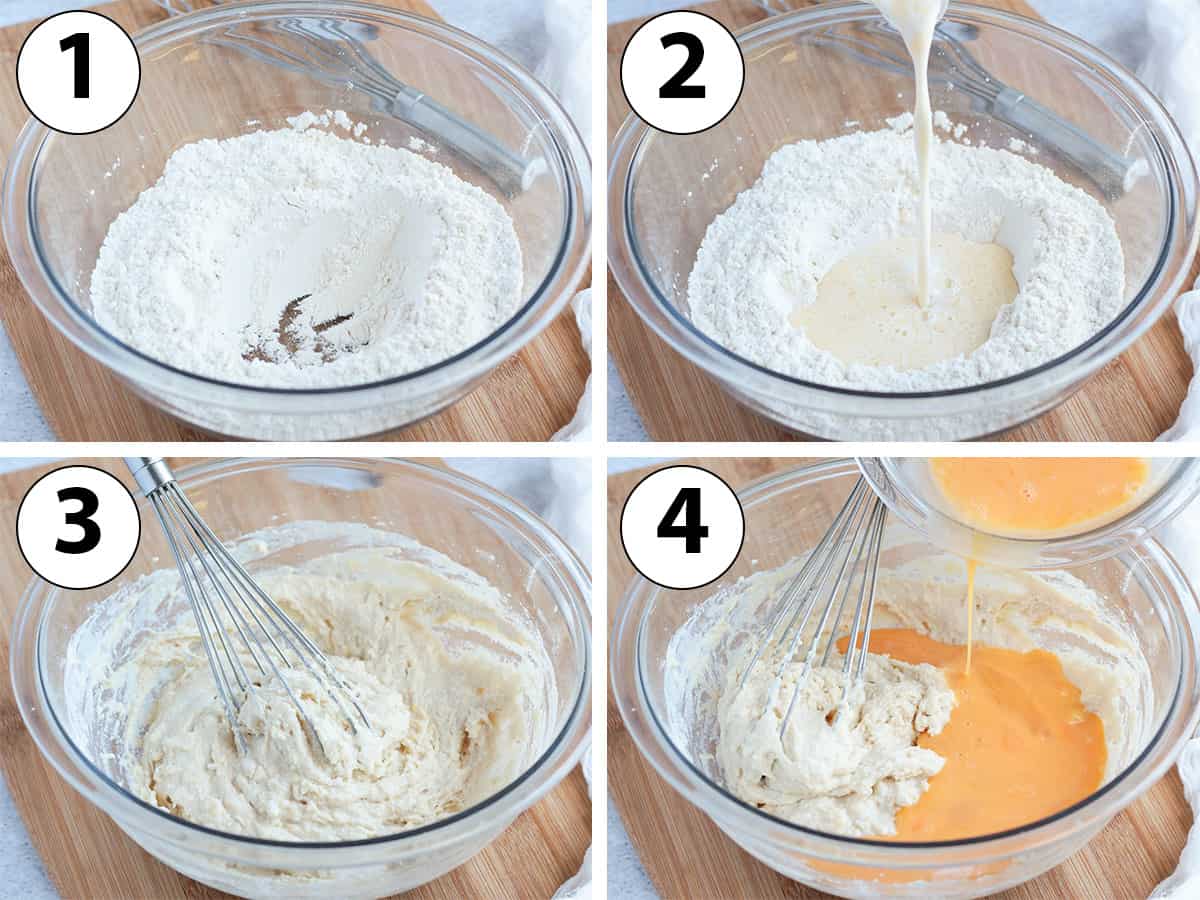
Before you begin, ensure all your ingredients are accurately measured and ready to go. This “mise en place” approach makes the process smooth and enjoyable.
- Begin by combining the Butter and Milk in a microwave-safe bowl or jug. Gently heat in the microwave until the butter has completely melted and is fully incorporated into the milk. Once melted, set this mixture aside to cool down slightly. This prevents the eggs from scrambling when added.
- In a separate small bowl, lightly whisk the Eggs until just combined. Set these aside for later incorporation.
- Photo 1: In a large mixing bowl, sift together the Flour, a pinch of Salt, and the Caster Sugar. Sifting helps prevent lumps and ensures a smoother batter. Mix these dry ingredients gently to combine, then create a large well (a hollow space) in the center by pushing the dry ingredients towards the sides of the bowl.
- Photo 2: Carefully pour about two-thirds of your cooled melted butter and milk mixture directly into the well you created in the dry ingredients.
- Photo 3: Using a whisk, gradually incorporate the liquid into the dry ingredients, starting from the center and working outwards. At this stage, you’ll achieve a rather thick and stiff batter, which is perfectly normal. Don’t worry about lumps just yet.
- Photo 4: Now, add the previously whisked Eggs to the batter. Whisking them separately first ensures they integrate more smoothly into the thicker batter, preventing over-mixing later on. Mix well to combine everything.

- Photo 5: Now, vigorously whisk the batter to break down any remaining lumps. A few small lumps are still acceptable at this point, as they will often disappear with further mixing and resting.
- Photo 6: Pour in the remaining melted Butter and Milk mixture, which will thin out the batter considerably.
- Photo 7: Continue whisking until you achieve a beautifully smooth and very liquid batter. The consistency should be thin enough to easily spread across the pan.
If, despite your best efforts, you still find persistent lumps in your batter, an immersion blender is a fantastic tool to quickly smooth it out to perfection.
- Cover the bowl tightly with plastic wrap and place it in the fridge to rest for at least one hour. For the absolute best results and deepest flavors, resting the batter overnight is highly recommended. This crucial step allows the flour to fully hydrate, preventing a rubbery texture, and helps the flavors meld and develop, resulting in a more tender and delicious crêpe.
Cooking Your Delicious French Crêpes

Once your beautifully rested batter is ready, it’s time for the most exciting part: cooking! This stage might require a little practice to achieve that perfectly round, paper-thin crêpe, but it’s a skill quickly mastered.
Mastering the Crêpe Pan
- Place your dedicated crêpe pan (a cast iron pan is excellent for superior heat distribution and results) over medium heat. Allow it to heat up properly. Then, very lightly grease the surface with a tiny bit of butter. A piece of kitchen paper can be used to spread the butter thinly and evenly.
- Photo 8: Take a ladleful of your smooth crêpe batter and pour it directly into the center of the preheated pan.
- Photo 9: Immediately and swiftly, use a crêpe spreader (a T-shaped wooden tool) to gently and evenly spread the batter outwards in a circular motion. Aim for a very thin, uniform, and perfectly round layer of batter across the pan. This technique is key to achieving traditional French thinness.
- Photo 10: Allow the crêpe to cook for a couple of minutes on the first side. The exact cooking time will vary based on the crêpe’s thickness and your stove’s heat. You’ll know it’s ready to flip when the edges begin to lift slightly from the pan and appear very slightly crisp, and the surface looks set. Use a thin wooden spatula to carefully lift an edge and then gently flip the crêpe over.
- Photo 11: Cook the crêpe on the second side for approximately one minute, or until it achieves a light golden color. The second side usually cooks much faster.
A crucial aspect of successful crêpe cooking is continuous temperature management. Your pan will naturally get hotter as you cook successive crêpes. Be prepared to decrease the stove’s temperature when needed, and then increase it again if the pan starts to cool too much. This ensures consistent cooking and prevents burning.
Cooking Crêpes in a Non-Stick Skillet
If you don’t own a specialized crêpe pan, a good quality non-stick skillet works perfectly well. Here’s how to adapt the technique:
Pick up a ladle of batter. Hold your non-stick pan at a slight angle, with one side tilted gently downwards. Pour the batter onto the highest side of the pan. Then, using a quick, circular wrist motion, swirl the pan to spread the batter thinly and evenly across the bottom, forming a delicate, round layer. Continue to cook, flip, and adjust heat as described for the crêpe pan, until each crêpe is beautifully golden.

Frequently Asked Questions About French Crêpes
The primary distinction lies in their leavening. Crêpes are made without any rising agents like baking powder, which results in their characteristic thin, delicate, and soft texture. Pancakes, on the other hand, typically include baking powder or similar agents, making them thicker and fluffier with a more cake-like consistency. Crêpes are designed to be a thin canvas for fillings, while pancakes are often enjoyed for their substantial fluffiness.
Resting the crêpe batter in the fridge for at least an hour (or preferably overnight) is a crucial step for achieving the best possible flavor and texture. During this resting period, the flour fully absorbs all the liquid, allowing the gluten to relax. This relaxation prevents the crêpes from becoming tough or rubbery and results in a more tender, pliable, and flavorful end product. It also helps any small lumps dissolve naturally.
Crêpe pans are often accompanied by specialized tools like a crêpe spreader and a thin, flat spatula for flipping. To cook, heat your crêpe pan over medium heat and lightly grease it. Pour a small ladleful of batter into the center. Immediately use the crêpe spreader, moving it in a circular motion, to gently and quickly spread the batter into a large, thin disk. Once the edges of the crêpe begin to lift and crisp slightly, use your spatula to carefully flip it over. Cook for a shorter period on the second side until lightly golden. Always use a wooden or silicone spatula to avoid damaging the pan’s surface.
Absolutely! If you don’t frequently make crêpes or are trying them for the first time, a regular non-stick pan or skillet will work perfectly. Simply follow the detailed instructions provided above for cooking crêpes in a non-stick pan. However, I must emphasize that using a proper Crêpe Pan, especially with its specialized spreader, truly is a game-changer. It makes achieving that perfectly thin, even layer much easier and faster than swirling the pan by hand, leading to more consistent and authentic results.
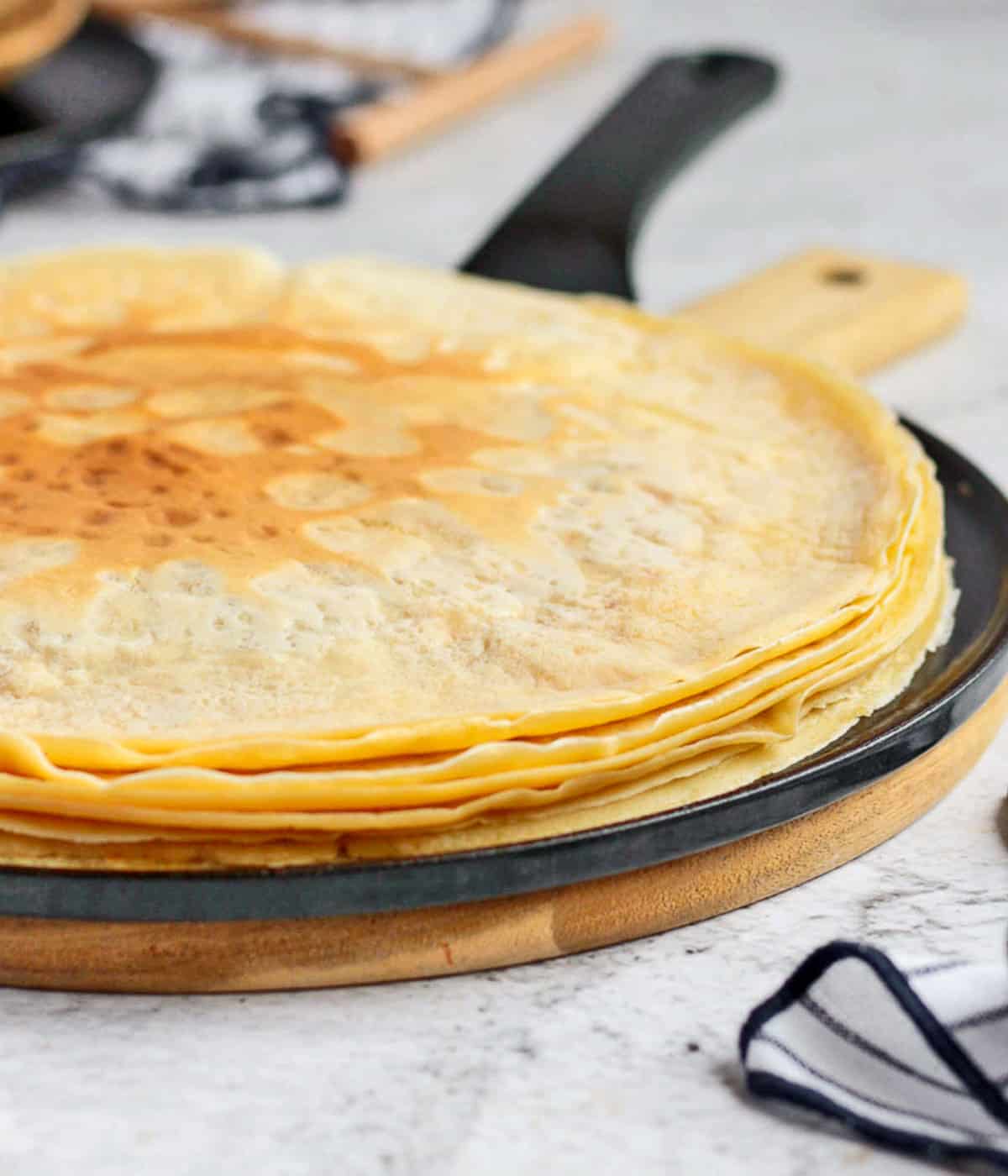
Expert Tips & Troubleshooting for Perfect Crêpes
Achieving the Ideal Crêpe Batter Consistency
Crêpe batter is quite forgiving, and its consistency can be adjusted at any point to reach perfection. Think of your very first crêpe as a “test crêpe” – it allows you to assess the batter and make any necessary tweaks. You’re aiming for a batter that is perfectly smooth, free of lumps, and quite liquid, allowing it to spread thinly.
- The batter is lumpy: Don’t despair! First, try whisking vigorously to break down those lumps. If some stubborn lumps still remain, a quick solution is to use an Immersion Blender. A few pulses will typically create a silky-smooth batter in seconds.
- The mixture is too thick: If your crêpes are coming out too thick, or the batter is difficult to spread, simply add a small amount of Milk, one tablespoon at a time. Whisk thoroughly after each addition until you achieve that desired very smooth, light, and wonderfully liquid consistency that flows easily.
- The batter is too thin: If your crêpes are breaking apart when you try to flip them, or the batter is excessively watery, it might be too thin. Gradually whisk in a little bit of all-purpose flour, one tablespoon at a time, until the batter reaches the correct consistency – thin enough to spread, but robust enough to hold together.
Flawless Crêpe Cooking
- Do you need to flip crêpes? Yes, absolutely! Crêpes need to cook on both sides to achieve that uniform golden color and delicate texture. However, the second side typically cooks much faster than the first, so be attentive.
- How thin should crêpes be? The goal is to make them as thin as possible, without them tearing or breaking apart when you attempt to flip them. Their signature elegance comes from their delicate, almost translucent quality.
- How do I know when a crêpe is ready to be flipped? There are several key indicators. Look for the edges of the crêpe; they will typically start to crisp up slightly and gently lift away from the pan. You might also notice small air bubbles forming and popping in the middle of the crêpe. If you’re unsure, you can always gently lift an edge with your spatula to peek at the color underneath – it should be a light golden brown, not too dark.
- How hot should the pan be? Start with your pan fairly hot, but be prepared to continuously adjust the temperature as you cook. This is perhaps the most crucial element to mastering crêpes. The pan will naturally heat up as you cook subsequent crêpes, so you’ll often need to slightly decrease the temperature of your stove. If the pan then becomes too cool, increase the heat again. Finding that sweet spot ensures even cooking and prevents burning or undercooked crêpes.
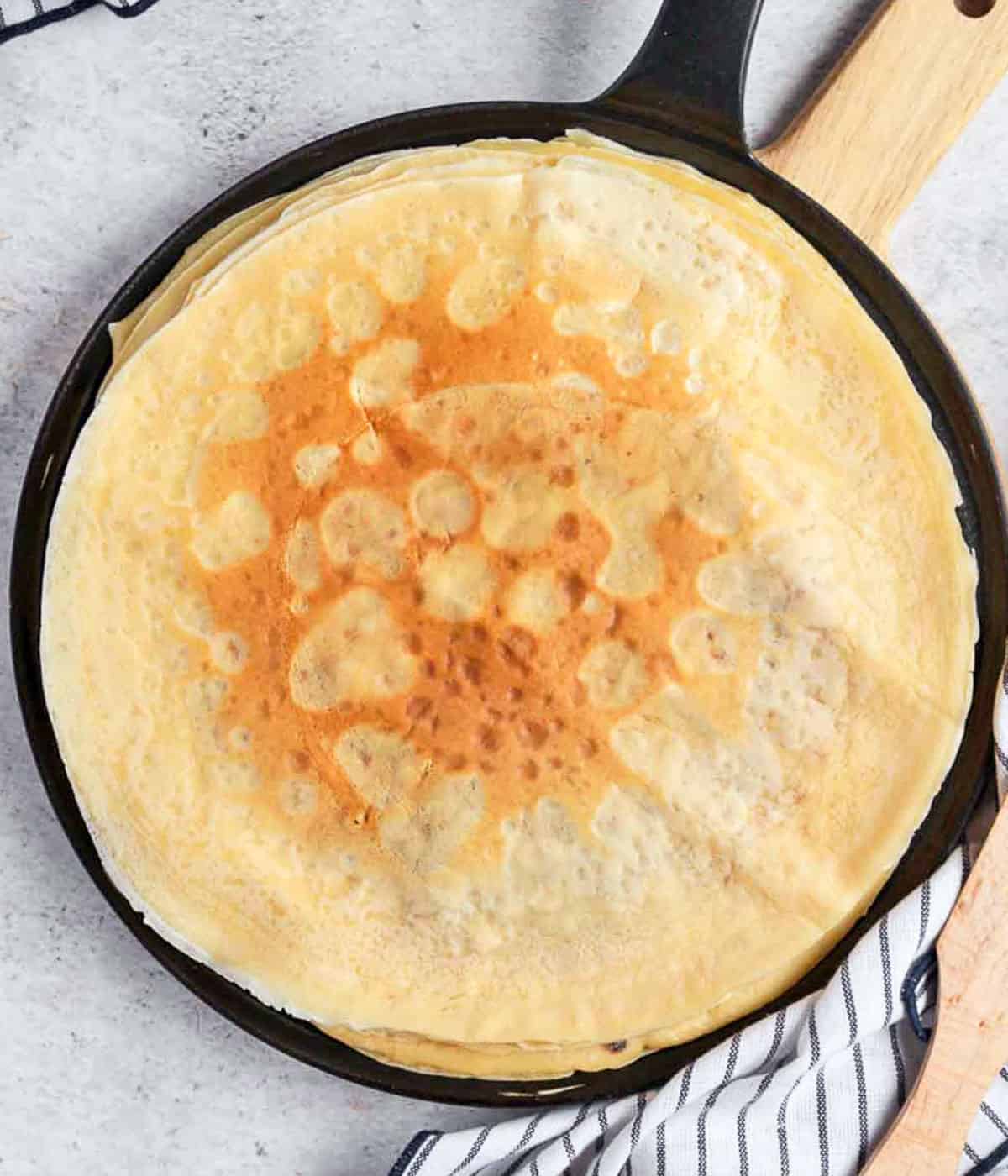
Endless Ways to Enjoy Your French Crêpes
One of the most wonderful aspects of this basic crêpe recipe is its incredible versatility. You can serve them exactly how you like, experimenting with different fillings every time! While I personally prefer my crêpes served warm, fresh off the pan, they are equally delicious enjoyed at room temperature or even chilled.
For fillings, the options are truly limitless, ranging from simple drizzles to elaborate cooked toppings – and, of course, a scoop of ice cream!
- Classic Sweetness: A sprinkle of Brown Sugar and a squeeze of fresh Lemon Juice for a timeless, zesty tang.
- Decadent Indulgence: Creamy Vanilla Ice Cream paired with a warm Hot Chocolate Sauce or a generous slather of smooth Nutella.
- Nutty Delight: A drizzle of homemade Hazelnut Praline Paste for a sophisticated, crunchy texture.
- Warm Fruit Compotes: Stewed fruits like Caramelised Apples, tart Stewed Rhubarb, or comforting Stewed Pears.
- Fresh Berry Sauces: Vibrant compotes such as Mixed Berry Compote, sweet Raspberry Compote, delightful Strawberry Compote, or juicy Blueberry Compote.
- Smooth Fruit Coulis: Elegant fruit purees like Strawberry Coulis, bright Raspberry Coulis, exotic Passion Fruit Coulis, or tropical Mango Coulis.
- Fresh Fruits & Cream: Slices of fresh berries, bananas, or peaches, beautifully complemented by a dollop of fluffy Whipped Cream, traditional Chantilly Cream, or even light and airy Whipped Ricotta.
- Tangy Fruit Curds: A spoonful of vibrant Lemon Curd, tropical Passion Fruit Curd, or zesty Orange Curd.
For even more creative and original ideas, be sure to explore my 30 Favorite Pancakes Toppings, many of which can be perfectly adapted to elevate your French Crêpes!
Savoury Filling Ideas: To create savory crêpes, simply omit the sugar from the batter. These provide a fantastic base for fillings like melted cheese, sautéed mushrooms, thinly sliced ham, caramelized onions, or creamy cooked leeks, offering a delicious alternative to sweet treats!
Storing & Freezing Your Crêpes
While crêpes are truly at their peak when eaten fresh off the pan, you might find yourself with a few leftovers (though I doubt it!). If you do, allow them to cool completely. Then, stack them with parchment paper between each crêpe to prevent sticking, cover the stack tightly with plastic wrap or aluminum foil, and store them in the fridge for 1 to 2 days. To serve, simply reheat them individually in a lightly greased pan or microwave until warm and pliable again. I generally do not recommend freezing crêpes, as their delicate texture can suffer upon thawing.
A helpful tip for keeping your crêpes warm and fresh as you cook a large batch is to place the cooked crêpes on a plate, cover them with aluminum foil, and keep them in an oven preheated to a very low temperature (around 150°F / 65°C) until you are ready to serve.

Discover More Classic French Recipes
- Easy French Apple Tart
- Cherry Clafoutis
- Choux à la Crème (French Cream Puffs)
- Strawberry Charlotte Cake
- Classic French Profiteroles
- Sablés Bretons Cookies (Salted Butter Cookies)
- Fraisier Cake
- Pear Frangipane Tartlets
- Brioche Bread French Toast
- Coffee Crème Brûlée
Made this recipe?
Let us know if you liked it by leaving a comment below, and tag us on Instagram @a.baking.journey with a photo of your creation!
Recipe Card: Easy French Crêpes
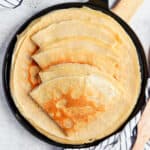
Easy French Crêpes
Servings:
12
large crepes
Author:
Sylvie
15 minutes
45 minutes
1 hour
2 hours
Print Recipe
Prevent your screen from going dark
Ingredients
- 30 gr (2 tablespoons) Unsalted Butter
- 500 ml (2 cups) Full Cream / Whole Milk
- 3 large Eggs
- 250 gr (1 2/3 cup) Plain / All Purpose Flour
- 15 gr (1 tablespoon) Caster Sugar, (discard to make savoury crepes)
- 1/3 teaspoon Fine Table Salt
Instructions
Crêpes Batter Preparation
- Combine the Butter and Milk in a heat-proof jug and warm them gently in the microwave until the butter has fully melted. Set this mixture aside to cool. In a separate small bowl, whisk the Eggs briefly and set them aside.
- Sift together the Flour, Salt, and Sugar into a large mixing bowl. Stir to combine, then create a deep well in the center by pushing the dry ingredients towards the sides of the bowl (see note 1 for details on making a well).
- Pour approximately 2/3 of the cooled melted butter and milk mixture into the well. Whisk vigorously to combine the liquid with the dry ingredients. The mixture will initially be quite stiff, which is the correct consistency at this stage.
- Add the whisked Eggs and mix thoroughly. Then, pour in the remaining butter and milk. Continue to whisk vigorously to eliminate any lumps until you achieve a perfectly smooth and very liquid batter (see note 2 for troubleshooting lumps).
- Cover the bowl securely with plastic wrap and refrigerate the batter for at least one hour. For optimal flavor development and texture, it is highly recommended to let the batter rest overnight (see note 3 for the benefits of resting).
Cooking the Crêpes in a Dedicated Crêpe Pan
- Heat your crêpe pan over medium heat. Lightly grease the pan’s surface with a small amount of butter, wiping away any excess with kitchen paper.
- Using a ladle, scoop a portion of the batter and pour it into the very center of the warm pan. Immediately use your crêpe spreader to distribute the batter in a quick, circular motion, creating a thin, even, and round crêpe.
- Allow the crêpe to cook for a couple of minutes on the first side (refer to note 4 for cooking time guidance). Once the edges start to lift slightly and appear lightly crisp, use a wooden spatula to gently lift and flip the crêpe. Continue cooking on the other side for about one minute, or until it turns a delicate golden brown.
- Repeat this process with the remaining batter until all crêpes are cooked.
Cooking the Crêpes in a Non-Stick Pan or Skillet
- Heat your non-stick pan or skillet over medium heat. Lightly grease it with butter (optional for very good non-stick surfaces), wiping away any excess.
- Scoop some batter with a ladle. Hold your pan at an angle, tilting one side slightly down. Pour the batter onto the highest side of the pan. Gently spread the batter by moving the pan (or your wrist) in a circular motion, allowing the batter to flow and coat the bottom in a thin, even layer.
- Cook the crêpe for a couple of minutes on the first side (see note 4). When the edges begin to lift and become slightly crisp, use a wooden or silicone spatula to carefully lift and flip it. Cook the other side for about one minute, or until it reaches a beautiful light golden hue.
- Continue this process until all the batter has been used and you have a stack of perfect crêpes.
Would you like to save this recipe?
We’ll email this post to you, so you can come back to it later!
Notes
- To make a well, simply push the center of the dry ingredients towards the sides of the bowl using a spoon or spatula, creating a hollow space for liquids.
- If you still have lumps in your batter after vigorous whisking, you can use an immersion blender to quickly smooth out the crêpe batter to a perfect consistency.
- It is crucial to let the batter rest, as this allows the flour to fully absorb the liquid and hydrate properly, leading to a tender texture and deeper flavors in your finished crêpes.
- The precise cooking time will vary depending on the thickness of your crêpe and the heat of your stove. A key to successful crêpe cooking is to continually adjust the stove’s temperature as needed. The pan will naturally get hotter as you cook, so decrease the temperature when necessary, then increase it again if the pan cools down too much.
Nutrition (per serving)
|
Carbohydrates: 19g
|
Protein: 5g
|
Fat: 5g
|
Saturated Fat: 2g
|
Cholesterol: 50mg
|
Sodium: 37mg
|
Potassium: 92mg
|
Fiber: 1g
|
Sugar: 3g
|
Vitamin A: 189IU
|
Calcium: 56mg
|
Iron: 1mg
